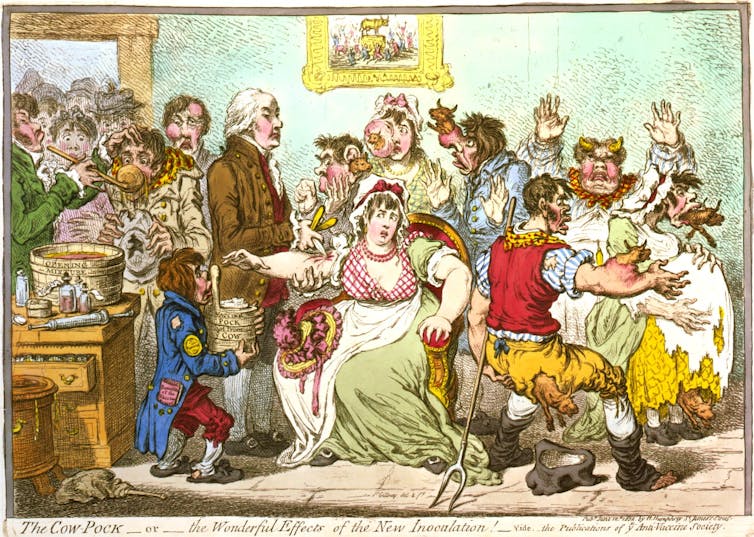If you were to watch a split-screen broadcast with global weather on one side and world politics on the other, you could easily conclude that we are doomed.
Prodigious storms and killer heat waves announce the arrival of human-induced climate change, with more disasters to come as the planet warms and ecosystems collapse.

But right-wing populism is rising faster than the oceans, sinking efforts to combat this and other global crises. Meanwhile, U.S. President Donald Trump keeps tweeting that climate change is fake news. Very bad!
And yet we humans have also shown that we can overcome even our most daunting problems. Exhibit A is our victory over smallpox, perhaps the most feared pathogen of all time.
Ancient scourge
The smallpox virus probably “jumped” from camels or other domesticated animals to people some 3,000 years ago, striking everyone from Chinese peasants to Egyptian pharaohs.
From our partners:
The highly contagious disease caused fever and tremors in infants, killing them even before the tell-tale rash broke out. Thousands of tiny pox appeared on the faces and hands of older victims, leaving many dead and many more disfigured.
By the medieval period, healers across Asia had learned to insert pus from a victim’s pox into the shoulder or thigh of a healthy but at-risk person. Known as inoculation, this procedure carried a two to five per cent death rate — much lower than full-blown smallpox — and usually brought on a mild case that still conferred lifelong immunity.
Europeans unwittingly gave the virus new life by delivering infected African slaves to hellish mines near Columbus’s landing spot on Hispaniola (Haiti and Dominican Republic) in 1518. From the islands, smallpox spread to the mainland, enabling the ruthless conquistadors to topple vast civilizations who had no natural immunity to “spotted death.”
The apocalypse that followed has no parallel in recorded history. In repeated outbreaks all over the Americas, smallpox killed up to 90 per cent of some Indigenous peoples. Among the worst hit were the Salish of Vancouver — their traditions speak of a “fearful dragon” whose hot breath fell upon the children, burning their skin into sores.
From inoculation to vaccination
But people fought back. Around 1720, Europeans and colonial Americans learned about inoculation from Ottoman and West African sources. During an outbreak in Boston, the Rev. Cotton Mather urged everyone to embrace this new method — and to ignore the bigots who dismissed it as “negro” or “Mahometan” (Islamic) sorcery.
Many used this technique for darker purposes. Wealthy planters on the British island of Barbados imposed near-universal inoculation by 1750 because they wanted to keep their slaves in the sugar fields. In the 1760s, British commanders protected their own troops and then spread the monster disease to native enemies. They probably did the same to rebel colonists in Boston a decade later.
Nonetheless, men and women with open minds worked to combat smallpox, the common enemy. They shared ideas with researchers from enemy nations and insisted that medical progress in service to humanity had no price and no borders.

The big breakthrough came in 1796, when Dr. Edward Jenner observed that English milkmaids never caught smallpox. He scraped the “milker’s nodules” on their hands and applied the infected material — a related virus known as cowpox or vaccinia — to his patients. Vaccination was born.
Despite his fear and loathing of England, U.S. President Thomas Jefferson wrote to Jenner with thanks on behalf of “the whole human family.”
Throughout the 19th and 20th centuries, wealthy countries vaccinated their people with increasing regularity. The U.S. even had a National Vaccine Institute until parsimonious congressmen killed it in 1822. Poorer countries in Africa and the Caribbean suffered longer, even though they had pioneered inoculation.
The lingering threat
In 1966, four years after the last case in Canada, the WHO resolved to wipe smallpox off the Earth. This remarkable project succeeded in large part because of the close co-operation of the U.S. and the Soviet Union — despite the Cold War.
Humanity has now been smallpox-free for more than 40 years. We no longer live in fear of another outbreak, nor recall the ghastly sight of a child in its clutches.
The downside is that most of us no longer have any immunity against this cruel foe, making us just as vulnerable as the first Americans were five centuries ago.
Officially, the virus only exists in two high-security laboratories in the U.S. and Russia. Because smallpox is stable in laboratory environments, however, old stocks from the days of inoculation may be hiding. Bioterrorists could weaponize such active matter.
If that were to happen, we would need new drugs such as tecovirimat, just approved by the U.S. government. We’d also require the intelligent use of vaccine stocks and a massive international effort to contain the outbreaks and the panic they’d spread. We’d need to overcome the inevitable resistance of anti-government and anti-science reactionaries.
All of that may seem impossible in 2018.
That’s why we need to remember our first triumph over smallpox as proof of our ingenuity and resilience, not to mention our capacity to work together for the health and happiness of our species.
Steven M Opal, Research Scientist and Clinical Professor of Medicine, Alpert Medical School of Brown University, Brown University and J.M. Opal, Associate Professor of History and Chair, History and Classical Studies, McGill University
This article is republished from The Conversation under a Creative Commons license. Read the original article.













